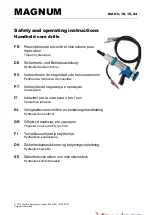
6 - English
The LED light, located on the foot of the tool, will turn on
when the switch trigger is depressed.
A whistling or ringing noise coming from the switch during
use is a normal part of the switch function.
Running at low speeds under constant usage may cause
the drill to become overheated. If this occurs, cool the drill
by running it without a load and at full speed.
This drill has an electric brake. When the switch trigger is
released, the chuck stops turning.
DIRECTION OF ROTATION SELECTOR
(FORWARD/REVERSE/CENTER LOCK)
See Figure 1, page 9.
Set the direction of rotation selector in the
OFF
(center lock)
position to lock the switch trigger and help prevent accidental
starting when not in use.
Position the direction of rotation selector to the left of the
switch trigger for forward drilling. Position the selector to the
right of the switch trigger to reverse the direction.
NOTE:
The drill will not run unless the direction of rotation
selector is pushed fully to the left or right.
NOTICE:
To prevent gear damage, always allow the chuck
to come to a complete stop before changing the
direction of rotation.
WARNING:
Battery tools are always in operating condition.
Lock the switch when not in use or carrying at your
side, when installing or removing the battery pack,
and when installing or removing bits.
INSTALLING/REMOVING BATTERY PACK
See Figure 2, page 9.
Lock the switch trigger.
Insert the battery pack into the product as shown.
Make sure the latches on each side of the battery pack
snap into place and the battery pack is secured in the
product before beginning operation.
Depress the latches to remove the battery pack.
For complete charging instructions, see the operator’s manu-
als for your battery pack and charger.
INSTALLING/REMOVING BITS
See Figures 3 - 4, pages 9 - 10.
The arrows on the keyless chuck indicate which direction
to rotate the chuck sleeve to tighten or release the drill bit.
Do not use a wrench to tighten or loosen the chuck jaws.
To install bits,
lock the switch trigger.
Open or close the chuck jaws until the opening is slightly
larger than the bit size you intend to use.
Raise the front of the drill slightly and insert the drill bit.
WARNING:
Make sure to insert the drill bit straight into the
chuck jaws. Do not insert the drill bit into the chuck
jaws at an angle, then tighten. This could cause
the drill bit to be thrown from the drill, resulting in
possible serious personal injury or damage to the
chuck.
Rotate the chuck sleeve to close and tighten the chuck
jaws.
WARNING:
Do not hold the chuck sleeve with one hand and
use the power of the drill to tighten the chuck jaws
on the drill bit. The chuck sleeve could slip in your
hand, or your hand could slip and come in contact
with the rotating drill bit. This could cause an acci-
dent resulting in serious personal injury.
To remove bits,
lock the switch trigger and open the
chuck jaws.
The bit provided with the drill can be placed in the storage
area, located on the rear of the drill base.
TWO-SPEED GEAR TRAIN
See Figure 5, page 10.
Select
low speed
(1)
for applications requiring higher
power and torque, such as driving screws and drilling in
metal.
Select high speed
(2)
for fast drilling or driving applications,
for drilling in wood or masonry.
NOTICE:
Never change speeds while the tool is running.
Failure to obey this caution could result in serious
damage to the drill.
ADJUSTING TORQUE
See Figure 6, page 10.
Rotate the adjustment ring to the proper torque setting for
the type of material and size of screw you are using.
• 1 - 4
For driving small screws
• 5 - 8
For driving screws into soft material
• 9 - 12
For driving screws into soft and hard
materials
• 13 - 16 For driving screws into hard wood
• 17 - 23 For driving large screws
•
For heavy drilling
OPERATION







































